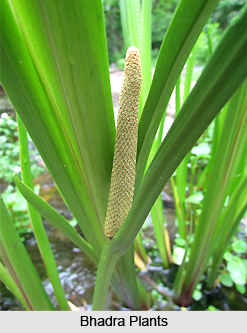 Bhadra or Gorbach is an Indian medicinal plant having a strong aroma. The scientific name of the herb is Acorus calamus L. The English names of the plant are Calamus, Sweet Hag or Sweet Root. Bhadra has several names in different Indian native languages. Among the Bengalis this Indian medicinal plant is known as Bach; in Gujarati, it is known as Gandhilovaj and Vekhand and its Hindi names are Bach, Gorbach or Vach. Down south Bhadra is popular as Bajai and Baje, in Tamil Nadu it is known as Vashambu and moreover, it is popular as Vadaja, Vasa and Vasa Vadaja in Telegu. In Marathi Bhadra is identified as Vekhand and Verkhand.
Bhadra or Gorbach is an Indian medicinal plant having a strong aroma. The scientific name of the herb is Acorus calamus L. The English names of the plant are Calamus, Sweet Hag or Sweet Root. Bhadra has several names in different Indian native languages. Among the Bengalis this Indian medicinal plant is known as Bach; in Gujarati, it is known as Gandhilovaj and Vekhand and its Hindi names are Bach, Gorbach or Vach. Down south Bhadra is popular as Bajai and Baje, in Tamil Nadu it is known as Vashambu and moreover, it is popular as Vadaja, Vasa and Vasa Vadaja in Telegu. In Marathi Bhadra is identified as Vekhand and Verkhand.
Bhadra is a semi-aquatic perennial Indian medicinal plant. The rhizomes of the plant are creeping, jointed and somewhat vertically compressed. They are about 1.3-2.5 cms thick and their colour of pale to dark brown. They are spongy inside. The plant`s leaves are narrow and have a length of up to 80 cm. The leaves are linear to narrowly ensiform; having a colour of glossy bright green and the apex is acute with the base amplexicaul. The petioles are sheathing for 20-50 cms. The pale green colour of Bhadra flowers have a sweet aroma of thir own. These are arranged compactly on a sessile, cylindrical and stumpy spadix.
The fruits of this Indian medicinal plant has are green, angular and fleshy. The fruits are 3-celled and each of them contains 1-3 oblong seeds. Bhadra or Gorbach plant is not a native to India; its origin is in Europe. However, it is widely cultivated and sometimes naturalized throughout India. The plant is most common in moist or marshy habitats between 300 and 2000 m elevation in the Himalayas.
Bhadra or Gorbach has numerous medicinal properties and usages and it is widely used in the Ayurvedic medicine. In Ayurveda, the dried rhizomes of the plant constitute the drug Vaca, which is considered to have antispasmodic, carminative and anthelmintic properties. The rhizomes are also considered to be capable of improving memory and intellect of a person. The rhizomes are used in various forms like as a powder, balm, enema or pills in the treatment of diseases like epilepsy, mental ailments, chronic diarrhoea, dysentery, bronchial catarrh, intermittent fevers, glandular and abdominal tumours. The rhizomes are used to treat liver and kidney ailments, flatulent colic, chronic dyspepsia, rheumatism and eczema.
The rhizomes of Bhadra are used as an ingredient in many compound Ayurvedic drugs and also in other traditional medicinal preparations. The rhizomes, roots and leaves of the plant yield a light brown to brownish-yellow volatile oil, commonly known as Calamus oil. The oil has carminative, antispasmodic and antibacterial properties. The Gonds of Uttar Pradesh take the root bark of Bhadra or Gorbach together with black pepper, and use it as an antidote for snake bites. However, the plant has some harmful properties as well. The rhizome of the plant is emetic in large doses and it may cause disturbed digestion and, in severe cases, gastroenteritis, under certain conditions.



















